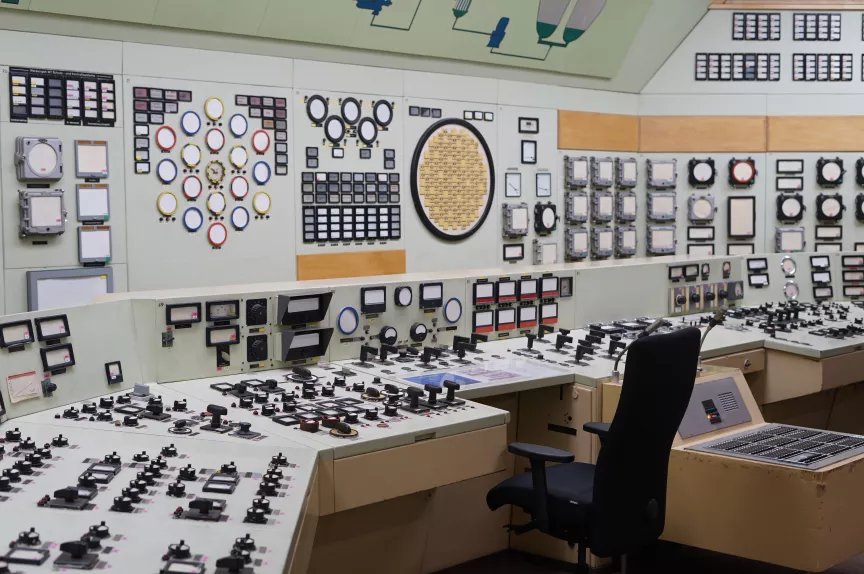Research Site: RHEINSBERG & LAKE STECHLIN
13.10.25

The Rheinsberg Nuclear Power Plant was the first such plant in the GDR, and it belonged to the first generation of research and experimental power plants for electricity generation globally. In operation from 1966 to 1990, the plant was shut down after German reunification and is now the first nuclear power plant in the world to be completely dismantled. The dismantling is considered a test run for future dismantling processes, which will occur in the near future due to the German nuclear phaseout. However, the preservation of the reactors as architectural monuments is still on the table, and the problem of storage for its highly radioactive components has not yet been solved.
As one of the largest companies in the region, with 650 workers during the time of its operation and more than 100 workers today for its dismantling, the Rheinsberg plant has an important place in the region’s self-image. For some time, the Rheinsberg City History Association has been working on the establishment of an information center or museum on the local history of the nuclear power plant. Today, the plant’s administration building enjoys historical preservation status as a prime example of GDR industrial architecture, joining the ranks of such local buildings as the Rheinsberg Castle, a prime example of the so-called Frederician Rococo.
The current operating company is a fully state-owned subsidiary of the federal government named Entsorgungswerk für Nuklearanlagen GmbH (EWN). It is responsible for the plant’s dismantling and the disposal of all of its parts. Since September 1998, following the decommissioning of the former GDR’s Morsleben nuclear repository in 1997, Rheinsberg’s radioactive waste has been transferred to the North Interim Storage Facility near Lubmin. Rheinsberg’s dismantled machines, components, and equipment as well as radioactive items such as nuclear fuel, parts of ist reactor core, and the reactor pressure vessel are now stored at the site of the former Greifswald Nuclear Power Plant. ENW was also responsible for the disposal of the low- and intermediate-level radioactive waste, which was stored in the plant’s own repository at Rheinsberg in the first years of its operation and has for many years polluted the site’s groundwater.
From today’s perspective, it is almost unimaginable, but the cooling water for the Rheinsberg Nuclear Power Plant came from the Stechlin nature reserve. The eponymous Lake Stechlin (Stechlinsee) located there is one of the most well-known lakes in the Mecklenburg Lake District, which became famous through a description in Theodor Fontane’s 1862 travelogue Wanderungen durch die Mark Brandenburg [Wanderings through the Mark of Brandenburg]. The lake is considered the most beautiful clearwater lake in northern Germany and is popular with divers because of its visibility depth of up to eleven meters. However, the lake is becoming more and more cloudy. For over sixty years, the depth of visibility has been studied by researchers at the Leibniz Institute of Freshwater Ecology and Inland Fisheries, which has a laboratory set up there. With its LakeLab, the institute generates high-resolution data investigating how water bodies react to changing conditions, such as nutrient pollution, global warming, and invasions of non-native species. It should be emphasized that the laboratory also collected data continuously throughout the time of the nuclear power plant’s operation, which means that there is incomplete but nevertheless extensive data on the lake. Due to the use of its water for cooling, Lake Stechlin warmed by several degrees during the nuclear power plant’s operation, which led to a change in the lake’s flora and fauna.
The warming water was an important reason for the GDR’s environmental movement to focus on nuclear energy’s effects on the area around the nuclear power plant, even though the East German government did not allow any criticism of nuclear power and to some extent suppressed it. As in West Germany, nuclear energy was considered a core technology of the future in the socialist state, through which the growing demand for energy was to be met via an alternative to brown coal. After the 1986 Chernobyl nuclear disaster, anti-nuclear resistance became a central concern of the East German environmental movement. At first, the Chernobyl disaster was not reported in the East German media, and this led to many GDR citizens being uninformed about its dangers such as acid rain and therefore unable to protect themselves. In order to counteract the glaring information and communication deficit and to undermine the state monopoly on information, the Berlin Environmental Library (Umweltsbibliothek) was founded in 1986, which, together with the Green-Ecological Network Arche, became centers for oppositional environmental work.



